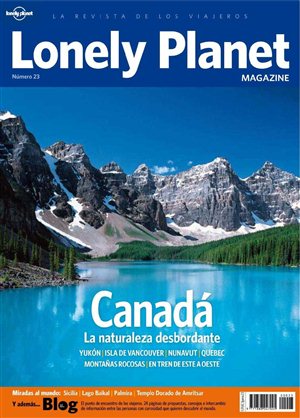Lonely Planet : World's largest travel publication
 Lonely Planet Publications (usually known as Lonely Planet or LP) is one of the largest travel guidebook publishers in the world. After Let’s Go Travel Guides, it was one of the first series of travel books aimed at backpackers and other low-cost travellers. As of 2008, it published about 500 titles in 8 languages, with annual sales of more than six million guidebooks,[citation needed] as well as TV programs, a magazine, podcasts and websites.
Lonely Planet Publications (usually known as Lonely Planet or LP) is one of the largest travel guidebook publishers in the world. After Let’s Go Travel Guides, it was one of the first series of travel books aimed at backpackers and other low-cost travellers. As of 2008, it published about 500 titles in 8 languages, with annual sales of more than six million guidebooks,[citation needed] as well as TV programs, a magazine, podcasts and websites.
Lonely Planet has a television production company, which has produced four series: Lonely Planet Six Degrees, The Sport Traveller, Going Bush, Vintage New Zealand and Bluelist Australia. Lonely Planet is headquartered in Footscray, a suburb of Melbourne, Australia, with affiliate offices in London and Oakland, California.
Since 2007, the company has been controlled by BBC Worldwide, which owns a 75% share, while founders Maureen and Tony Wheeler own the remaining 25%.
In 2009 Lonely Planet began publishing a monthly travel magazine called Lonely Planet Magazine.
The company name comes from a misheard line in “Space Captain,” a song by Joe Cocker and Leon Russell. The actual words are “lovely planet” but Tony Wheeler heard “lonely planet” and liked it.
A recent edition of Lonely Planet’s guide to Australia.Lonely Planet’s first book, Across Asia on the Cheap, was written and published by Englishman Tony Wheeler, a former engineer at Chrysler Corp and the University of Warwick and London Business School graduate, and his wife Maureen Wheeler in Sydney in 1973, following a lengthy trip from Turkey, through Iran, Afghanistan and Pakistan, to India or Nepal. The popularity of the overland route declined when Iran’s borders closed in 1979. Written with strong opinions, it sold well enough in Australia that it allowed the couple to expand it into South-East Asia on a Shoestring (nicknamed the ‘Yellow Bible’), which remains one of the company’s biggest sellers.
Lonely Planet’s first books catered to young people from Australia and Europe (mainly the UK) undertaking the overland hippie trail between Australia and Europe, via South-East Asia, the Indian subcontinent and the Middle East. This was becoming something of a rite of passage for young travellers, especially Australians and New Zealanders, who spent months (or years) on the journey.
Tourist facilities were limited in most of the countries en route, and low-budget tourism was rare.
The guidebook series expanded initially in Asia, with the India guidebook, first published in 1981. In the 1990s the company expanded into Europe and North America. The company currently publishes about 500 titles. In addition to books on most countries in the world, it publishes a range of specialised thematic guidebooks. The current Lonely Planet range also includes hardback photography books, food guides, city guides, travelogues, diaries and calendars, language guides, walking guides and more specialised guides (eg. a guide on Volunteer travel or a National Park guide).
Over the years its target audience has expanded from budget-conscious backpackers to include more mainstream and affluent travellers.
On 1 October 2007, a 75% stake in the company was purchased by BBC Worldwide, the commercial arm of the British Broadcasting Corporation, with the Wheelers retaining the other 25%. The Wheelers announced that this was so they could spend more time travelling.
Lonely Planet’s online community, the Thorn Tree is used by over half a million travellers for trade tips and advice. The Lonely Planet website was upgraded in 2008; new features include the ability to rate and review sites and restaurants, save them to a favourites list as well as a Trip Planner tool. The company is developing mobile websites and iPhone products.
How Lonely Planet was started
That’s all Tony and Maureen Wheeler needed for the trip of a lifetime. They met on a park bench in Regent’s Park and married a year later. For their honeymoon, they decided to attempt what few people thought possible - crossing Europe and Asia overland, all the way to Australia. It took them several months and all the money they could earn, beg or borrow, but they made it. And at the end of it all, they were flat broke… and couldn’t have been happier.
It was too amazing an experience to keep to themselves. Urged on by their friends, they stayed up nights at their kitchen table writing, typing and stapling together their very first travel guide, Across Asia on the Cheap.
Within a week they’d sold 1500 copies and Lonely Planet was born. Two years later, their second journey led to South-East Asia on a shoestring, which led to books on Nepal, Australia, Africa, and India, which led to… you get the picture.
As Lonely Planet became a globally loved brand, Tony and Maureen received several offers for the company. But it wasn’t until 2007 that they found a partner whom they trusted to remain true to Lonely Planet’s principles. In October of that year, BBC Worldwide acquired a 75% share in Lonely Planet, pledging to uphold Lonely Planet’s commitment to independent travel, trustworthy advice and editorial independence.
Today, Lonely Planet has offices in Melbourne, London and Oakland, with over 500 staff members and 300 authors. Tony and Maureen are still actively involved with Lonely Planet. They’re travelling more often than ever, and they’re devoting their spare time to charitable projects. And the company is still driven by the philosophy in Across Asia on the Cheap: ‘All you’ve got to do is decide to go and the hardest part is over. So go!’

